2004 ISUZU TF SERIES Accelerator Pedal Position
[x] Cancel search: Accelerator Pedal PositionPage 1436 of 4264
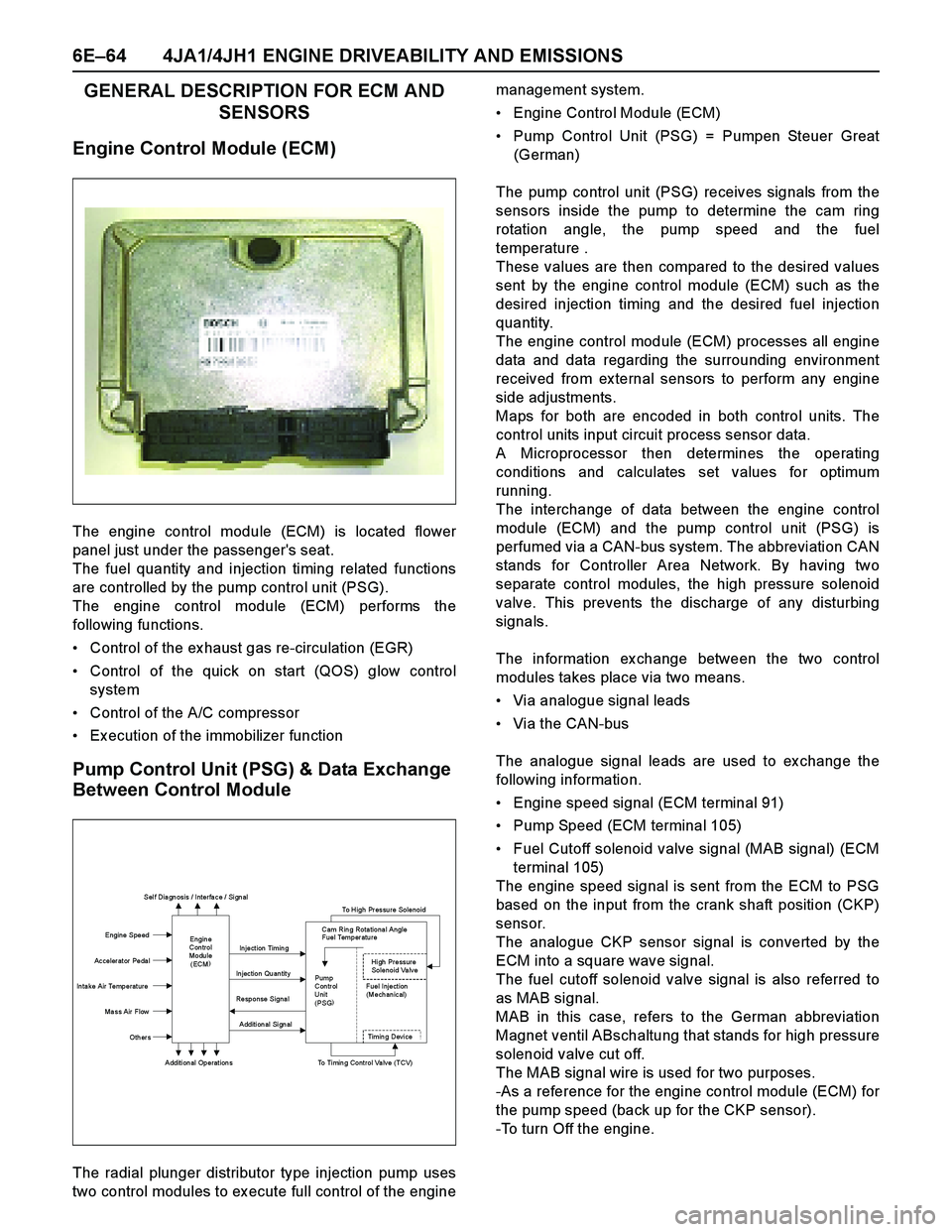
6E–64 4JA1/4JH1 ENGINE DRIVEABILITY AND EMISSIONS
GENERAL DESCRIPTION FOR ECM AND
SENSORS
Engine Control Module (ECM)
The engine control module (ECM) is located flower
panel just under the passenger's seat.
The fuel quantity and injection timing related functions
are controlled by the pump control unit (PSG).
The engine control module (ECM) performs the
following functions.
Control of the ex haust gas re-circulation (EGR)
Control of the quick on start (QOS) glow control
system
Control of the A/C compressor
Ex ecution of the immobilizer function
Pump Control Unit (PSG) & Data Exchange
Between Control Module
The radial plunger distributor type injection pump uses
two control modules to ex ecute full control of the enginemanagement system.
Engine Control Module (ECM)
Pump Control Unit (PSG) = Pumpen Steuer Great
(German)
The pump control unit (PSG) receives signals from the
sensors inside the pump to determine the cam ring
rotation angle, the pump speed and the fuel
temperature .
These values are then compared to the desired values
sent by the engine control module (ECM) such as the
desired injection timing and the desired fuel injection
quantity.
The engine control module (ECM) processes all engine
data and data regarding the surrounding environment
received from ex ternal sensors to perform any engine
side adjustments.
Maps for both are encoded in both control units. The
control units input circuit process sensor data.
A Microprocessor then determines the operating
conditions and calculates set values for optimum
running.
The interchange of data between the engine control
module (ECM) and the pump control unit (PSG) is
perfumed via a CAN-bus system. The abbreviation CAN
stands for Controller Area Network. By having two
separate control modules, the high pressure solenoid
valve. This prevents the discharge of any disturbing
signals.
The information ex change between the two control
modules takes place via two means.
Via analogue signal leads
Via the CAN-bus
The analogue signal leads are used to ex change the
following information.
Engine speed signal (ECM terminal 91)
Pump Speed (ECM terminal 105)
Fuel Cutoff solenoid valve signal (MAB signal) (ECM
terminal 105)
The engine speed signal is sent from the ECM to PSG
based on the input from the crank shaft position (CKP)
sensor.
The analogue CKP sensor signal is converted by the
ECM into a square wave signal.
The fuel cutoff solenoid valve signal is also referred to
as MAB signal.
MAB in this case, refers to the German abbreviation
Magnet ventil ABschaltung that stands for high pressure
solenoid v alv e cut off.
The MAB signal wire is used for two purposes.
-As a reference for the engine control module (ECM) for
the pump speed (back up for the CKP sensor).
-To turn Off the engine.
Sel f Dia gn osis / Interfa ce / Si gn al
To High Pressure Solenoid
Engine Speed
Injection Timing
Accelerator Pedal
Injection Quantity
In ta ke Air Temperat ure
Response Signal
Ma ss Air Flow
Additional Signal
Others
Additional Operations To Timing Control Valve (TCV)
Engin e
Con trol
Modu le
(ECM) Cam Rin g Rota tiona l Angle
Fuel Temper atu re
High Pressure
Solenoid Valve
Pump
Con tr ol Fuel Inject ion
Unit (Mechanical)
(PSG)
Ti m i n
g Devi ce
Page 1438 of 4264

6E–66 4JA1/4JH1 ENGINE DRIVEABILITY AND EMISSIONS
Throttle Position Sensor (TPS)
The TPS is a potentiometer connected to throttle shaft
on the throttle body. It is installed to the main TPS and
idle switch.
The engine control module (ECM) monitors the voltage
on the signal line and calculates throttle position. As the
throttle valve angle is changed when accelerator pedal
moved. The TPS signal also changed at a moved
throttle valve. As the throttle valve opens, the output
increases so that the output voltage should be high.
The engine control module (ECM) calculates fuel
delivery based on throttle valve angle.
Crankshaft Position (CKP) Sensor
The CKP sensor is located on top of the flywheel
housing of the flywheel and fix ed with a bolt.
The CKP sensor is of the magnet coil type. The
inductive pickup sensors four gaps in the flywheel
ex citer ring and is used to determine the engine speed
and engine cylinder top dead center (TDC). (1) Throttle Position Sensor (TPS)
(2) Idle Switch
1 2
Characteristic of TPS -Reference-
0 0.51 1.52 2.53 3.54 4.5
0 5 10 15 20 25 30 35 40 45 50 55 60 65 70 75 80 85 90 95 100
Pedal Position (%) (Tech2 Readin
g
Output Voltage (V)
(1) Crankshaft Position (CKP) Sensor
(2) Fly wheel with sensor slot
1 2
Page 1460 of 4264
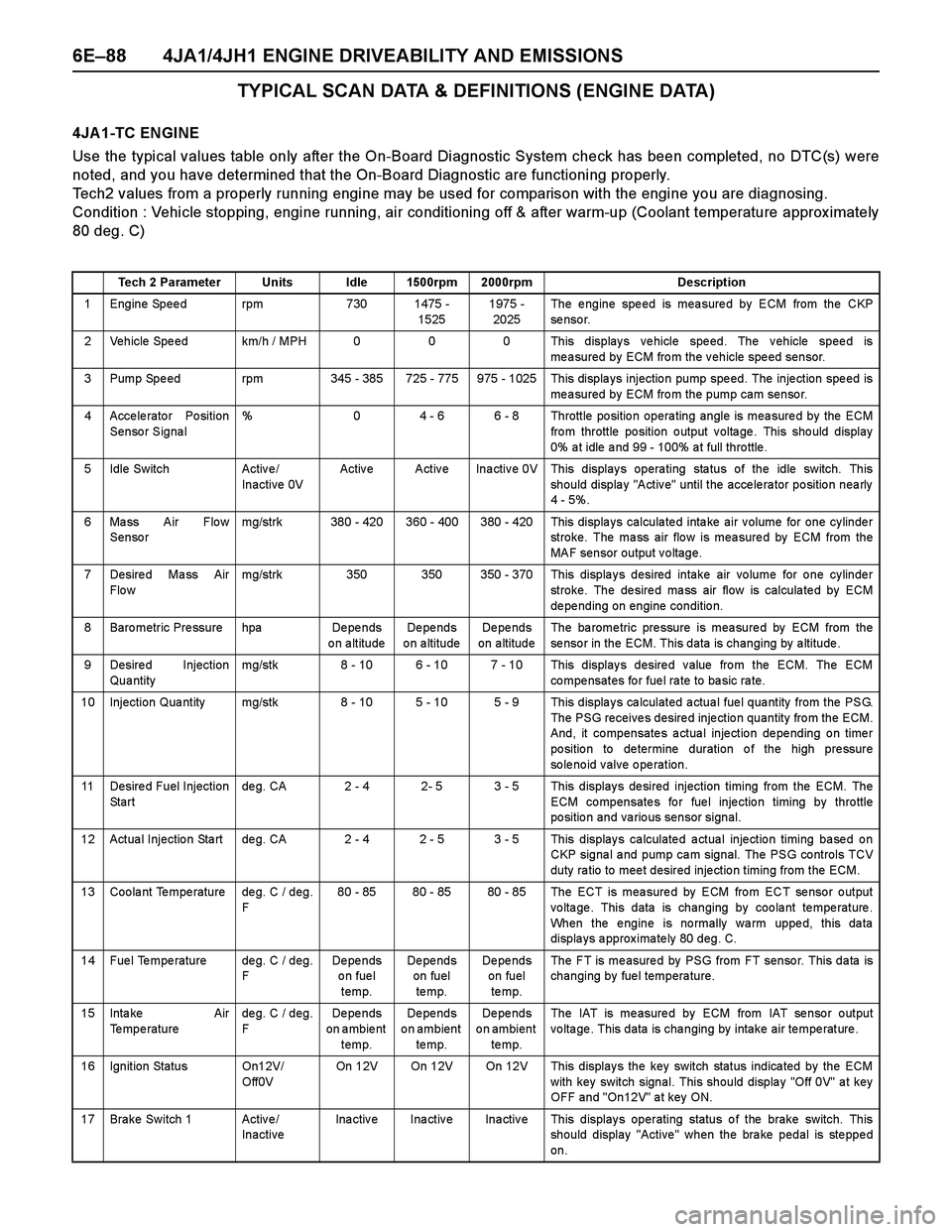
6E–88 4JA1/4JH1 ENGINE DRIVEABILITY AND EMISSIONS
TYPICAL SCAN DATA & DEFINITIONS (ENGINE DATA)
4JA 1-TC ENGINE
Use the typical values table only after the On-Board Diagnostic System check has been completed, no DTC(s) were
noted, and you have determined that the On-Board Diagnostic are functioning properly.
Tech2 values from a properly running engine may be used for comparison with the engine you are diagnosing.
Condition : Vehicle stopping, engine running, air conditioning off & after warm-up (Coolant temperature approx imately
80 deg. C)
Tech 2 Parameter Units Idle 1500rpm 2000rpm Description
1 Engine Speed rpm 730 1475 -
15251975 -
2025The engine speed is measured by ECM from the CKP
se nso r.
2 Vehicle Speed km/h / MPH 0 0 0 This displays vehicle speed. The vehicle speed is
measured by ECM from the vehicle speed sensor.
3 Pump Spe ed rpm 345 - 385 725 - 775 975 - 1025 This displa ys injectio n pump spe ed. The inje ction spe ed is
measured by ECM from the pump cam sensor.
4 Accelerator Position
Sensor Signal% 0 4 - 6 6 - 8 Throttle position operating angle is measured by the ECM
fro m throttle po sition o utput v olta ge . This sho uld display
0% a t idle a nd 99 - 100% a t full thro ttle .
5 Idle Switch Activ e /
Inactive 0VActive Active Inactive 0V This displays operating status of the idle switch. This
should display "Active" until the accelerator position nearly
4 - 5%.
6 Mass Air Flow
Sensormg/strk 380 - 420 360 - 400 380 - 420 This displays calculated intake air volume for one cylinder
stroke. The mass air flow is measured by ECM from the
MAF sensor output voltage.
7 Desire d Ma ss Air
Flo wmg/strk 350 350 350 - 370 This displays desired intake air volume for one cylinder
stroke. The desired mass air flow is calculated by ECM
de pe nding on engine conditio n.
8 Baro metric Pre ssure hpa De pe nds
on altitudeDe pe nds
o n a ltitudeDe pe nds
on altitudeThe ba rome tric pre ssure is mea sure d by ECM from the
sensor in the ECM. This data is changing by altitude.
9 Desired Injection
Qua ntitymg/stk 8 - 10 6 - 10 7 - 10 This displays desired value from the ECM. The ECM
co mpe nsates fo r fue l ra te to ba sic ra te.
10 Injection Qua ntity mg/stk 8 - 10 5 - 10 5 - 9 This displa y s ca lculated a ctua l fue l qua ntity from the PSG.
The PSG receives desired injection quantity from the ECM.
And, it compensates actual injection depending on timer
po sitio n to de termine duration o f the high pre ssure
solenoid valve operation.
11 Desire d Fuel Injection
St a r tde g. CA 2 - 4 2- 5 3 - 5 This display s de sired injection timing from the ECM. The
ECM compensates for fuel injection timing by throttle
position and various sensor signal.
12 Actua l Injectio n Sta rt de g. CA 2 - 4 2 - 5 3 - 5 This display s ca lculate d a ctua l inje ctio n timing ba se d o n
CKP signa l a nd pump ca m signal. The PSG controls TCV
duty ra tio to mee t desired inje ctio n timing from the ECM.
13 Coolant Temperature deg. C / deg.
F80 - 85 80 - 85 80 - 85 The ECT is measured by ECM from ECT sensor output
voltage. This data is changing by coolant temperature.
When the engine is normally warm upped, this data
displays approximately 80 deg. C.
14 Fuel Temperature deg. C / deg.
FDe pe nds
on fuel
temp.De pe nds
on fuel
te mp.De pe nds
on fuel
te mp.The FT is measured by PSG from FT sensor. This data is
changing by fuel temperature.
15 Inta ke Air
Temperaturedeg. C / deg.
FDe pe nds
on ambient
temp.De pe nds
on ambient
te mp.De pe nds
on ambient
te mp.The IAT is measured by ECM from IAT sensor output
voltage. This data is changing by intake air temperature.
16 Ignition Status On12V/
Off0VOn 12V On 12V On 12V This displays the key switch status indicated by the ECM
with key switch signal. This should display "Off 0V" at key
OFF and "On12V" at key ON.
17 Brake Switch 1 Active/
InactiveInactive Inactive Inactive This displays operating status of the brake switch. This
should display "Active" when the brake pedal is stepped
on.
Page 1462 of 4264
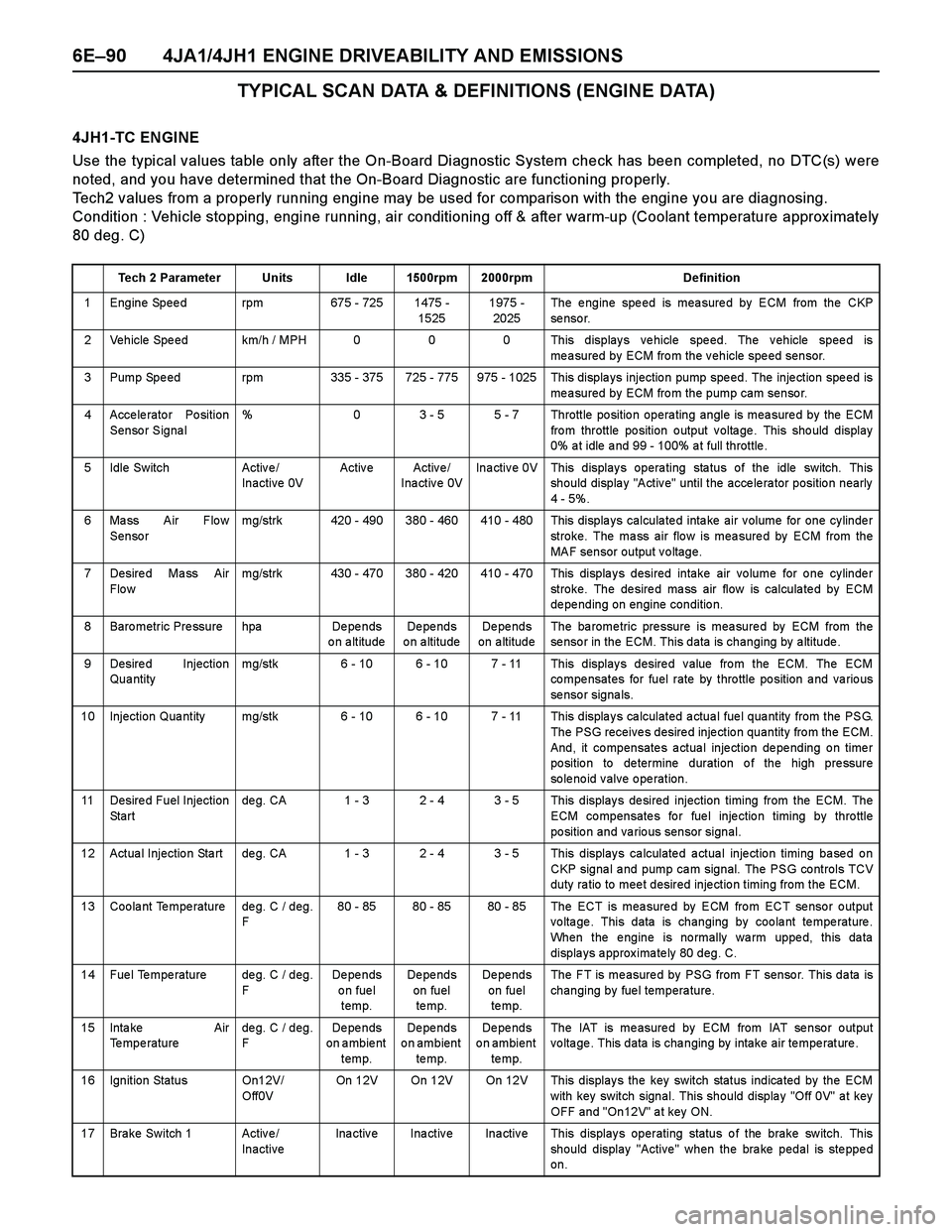
6E–90 4JA1/4JH1 ENGINE DRIVEABILITY AND EMISSIONS
TYPICAL SCAN DATA & DEFINITIONS (ENGINE DATA)
4JH1-TC ENGINE
Use the typical values table only after the On-Board Diagnostic System check has been completed, no DTC(s) were
noted, and you have determined that the On-Board Diagnostic are functioning properly.
Tech2 values from a properly running engine may be used for comparison with the engine you are diagnosing.
Condition : Vehicle stopping, engine running, air conditioning off & after warm-up (Coolant temperature approx imately
80 deg. C)
Tech 2 Parameter Units Idle 1500rpm 2000rpm Definition
1 Engine Speed rpm 675 - 725 1475 -
15251975 -
2025The engine speed is measured by ECM from the CKP
se nso r.
2 Vehicle Speed km/h / MPH 0 0 0 This displays vehicle speed. The vehicle speed is
measured by ECM from the vehicle speed sensor.
3 Pump Spe ed rpm 335 - 375 725 - 775 975 - 1025 This displa ys injectio n pump spe ed. The inje ction spe ed is
measured by ECM from the pump cam sensor.
4 Accelerator Position
Sensor Signal% 0 3 - 5 5 - 7 Throttle position operating angle is measured by the ECM
fro m throttle po sition o utput v olta ge . This sho uld display
0% a t idle a nd 99 - 100% a t full throttle .
5 Idle Switch Activ e /
Inactive 0VActive Active/
Inactive 0VInactive 0V This displays operating status of the idle switch. This
should display "Active" until the accelerator position nearly
4 - 5%.
6 Mass Air Flow
Sensormg/strk 420 - 490 380 - 460 410 - 480 This displays calculated intake air volume for one cylinder
stroke. The mass air flow is measured by ECM from the
MAF sensor output voltage.
7 Desire d Ma ss Air
Flo wmg/strk 430 - 470 380 - 420 410 - 470 This displays desired intake air volume for one cylinder
stroke. The desired mass air flow is calculated by ECM
de pe nding on engine conditio n.
8 Baro metric Pre ssure hpa De pe nds
on altitudeDe pe nds
o n a ltitudeDe pe nds
on altitudeThe ba rome tric pre ssure is mea sure d by ECM from the
sensor in the ECM. This data is changing by altitude.
9 Desired Injection
Qua ntitymg/stk 6 - 10 6 - 10 7 - 11 This displays desired value from the ECM. The ECM
co mpe nsates for fuel rate by thro ttle po sition a nd va rio us
se nso r signa ls.
10 Injection Qua ntity mg/stk 6 - 10 6 - 10 7 - 11 This displa y s ca lculated a ctua l fue l qua ntity from the PSG.
The PSG receives desired injection quantity from the ECM.
And, it compensates actual injection depending on timer
po sitio n to de termine duration o f the high pre ssure
solenoid valve operation.
11 Desire d Fuel Injection
St a r tde g. CA 1 - 3 2 - 4 3 - 5 This display s de sired injection timing from the ECM. The
ECM compensates for fuel injection timing by throttle
position and various sensor signal.
12 Actua l Injectio n Sta rt de g. CA 1 - 3 2 - 4 3 - 5 This display s ca lculate d a ctua l inje ctio n timing ba se d o n
CKP signa l a nd pump ca m signal. The PSG controls TCV
duty ra tio to mee t desired inje ctio n timing from the ECM.
13 Coolant Temperature deg. C / deg.
F80 - 85 80 - 85 80 - 85 The ECT is measured by ECM from ECT sensor output
voltage. This data is changing by coolant temperature.
When the engine is normally warm upped, this data
displays approximately 80 deg. C.
14 Fuel Temperature deg. C / deg.
FDe pe nds
on fuel
temp.De pe nds
on fuel
te mp.De pe nds
on fuel
te mp.The FT is measured by PSG from FT sensor. This data is
changing by fuel temperature.
15 Inta ke Air
Temperaturedeg. C / deg.
FDe pe nds
on ambient
temp.De pe nds
on ambient
te mp.De pe nds
on ambient
te mp.The IAT is measured by ECM from IAT sensor output
voltage. This data is changing by intake air temperature.
16 Ignition Status On12V/
Off0VOn 12V On 12V On 12V This displays the key switch status indicated by the ECM
with key switch signal. This should display "Off 0V" at key
OFF and "On12V" at key ON.
17 Brake Switch 1 Active/
InactiveInactive Inactive Inactive This displays operating status of the brake switch. This
should display "Active" when the brake pedal is stepped
on.
Page 1496 of 4264
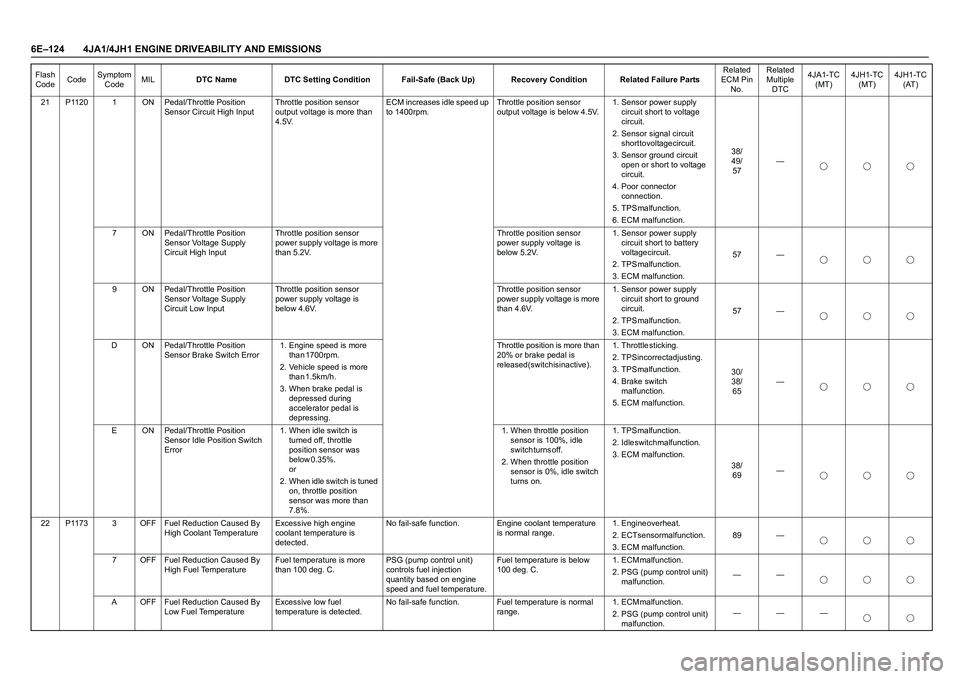
6E–124 4JA1/4JH1 ENGINE DRIVEABILITY AND EMISSIONS
21 P1120 1 ON Pedal/Throttle Position
Sensor Circuit High InputThrottle position sensor
output voltage is more than
4.5V.ECM increases idle speed up
to 1400rpm.Throttle position sensor
output voltage is below 4.5V.1. Sensor power supply
circuit short to voltage
c i r c u i t .
2. Sensor signal circuit
short to voltage circuit.
3. Sensor ground circuit
open or short to voltage
c i r c u i t .
4. Poor connector
c o n n e c t i o n .
5 . T P S m a l f u n c t i o n .
6. ECM malfunction.3 8 /
4 9 /
57—
7 ON Pedal/Throttle Position
Sensor Voltage Supply
Circuit High InputThrottle position sensor
power supply voltage is more
than 5.2V.Throttle position sensor
power supply voltage is
below 5.2V.1. Sensor power supply
circuit short to battery
voltage circuit.
2 . T P S m a l f u n c t i o n .
3. ECM malfunction.57 —
9 ON Pedal/Throttle Position
Sensor Voltage Supply
Circuit Low InputThrottle position sensor
power supply voltage is
below 4.6V.Throttle position sensor
power supply voltage is more
than 4.6V.1. Sensor power supply
circuit short to ground
c i r c u i t .
2 . T P S m a l f u n c t i o n .
3. ECM malfunction.57 —
D ON Pedal/Throttle Position
Sensor Brake Switch Error1. Engine speed is more
t h a n 1 7 0 0 r p m .
2. Vehicle speed is more
t h a n 1 . 5 k m / h .
3. When brake pedal is
depressed during
accelerator pedal is
d e p r e s s i n g . Throttle position is more than
20% or brake pedal is
released (switch is inactive). 1 . T h r o t t l e s t i c k i n g .
2. TPS incorrect adjusting.
3 . T P S m a l f u n c t i o n .
4. Brake switch
m a l f u n c t i o n .
5. ECM malfunction.3 0 /
3 8 /
65—
E ON Pedal/Throttle Position
Sensor Idle Position Switch
Error1. When idle switch is
turned off, throttle
position sensor was
b e l o w 0 . 3 5 % .
o r
2. When idle switch is tuned
on, throttle position
sensor was more than
7.8%.1. When throttle position
sensor is 100%, idle
s w i t c h t u r n s o f f .
2. When throttle position
sensor is 0%, idle switch
turns on.1 . T P S m a l f u n c t i o n .
2. Idle switch malfunction.
3. ECM malfunction.
3 8 /
69—
22 P1173 3 OFF Fuel Reduction Caused By
High Coolant TemperatureExcessive high engine
coolant temperature is
detected.No fail-safe function. Engine coolant temperature
is normal range.1 . E n g i n e o v e r h e a t .
2. ECT sensor malfunction.
3. ECM malfunction.89 —
7 OFF Fuel Reduction Caused By
High Fuel TemperatureFuel temperature is more
than 100 deg. C.PSG (pump control unit)
controls fuel injection
quantity based on engine
speed and fuel temperature.Fuel temperature is below
100 deg. C.1 . E C M m a l f u n c t i o n .
2. PSG (pump control unit)
malfunction.——
A OFF Fuel Reduction Caused By
Low Fuel TemperatureExcessive low fuel
temperature is detected.No fail-safe function. Fuel temperature is normal
range.1 . E C M m a l f u n c t i o n .
2. PSG (pump control unit)
malfunction.——— Flash
CodeCodeSymptom
CodeMILDTC Name DTC Setting Condition Fail-Safe (Back Up) Recovery Condition Related Failure PartsRelated
ECM Pin
No.Related
Multiple
DTC4JA1-TC
(MT)4JH1-TC
(MT)4JH1-TC
(AT)
Page 1600 of 4264
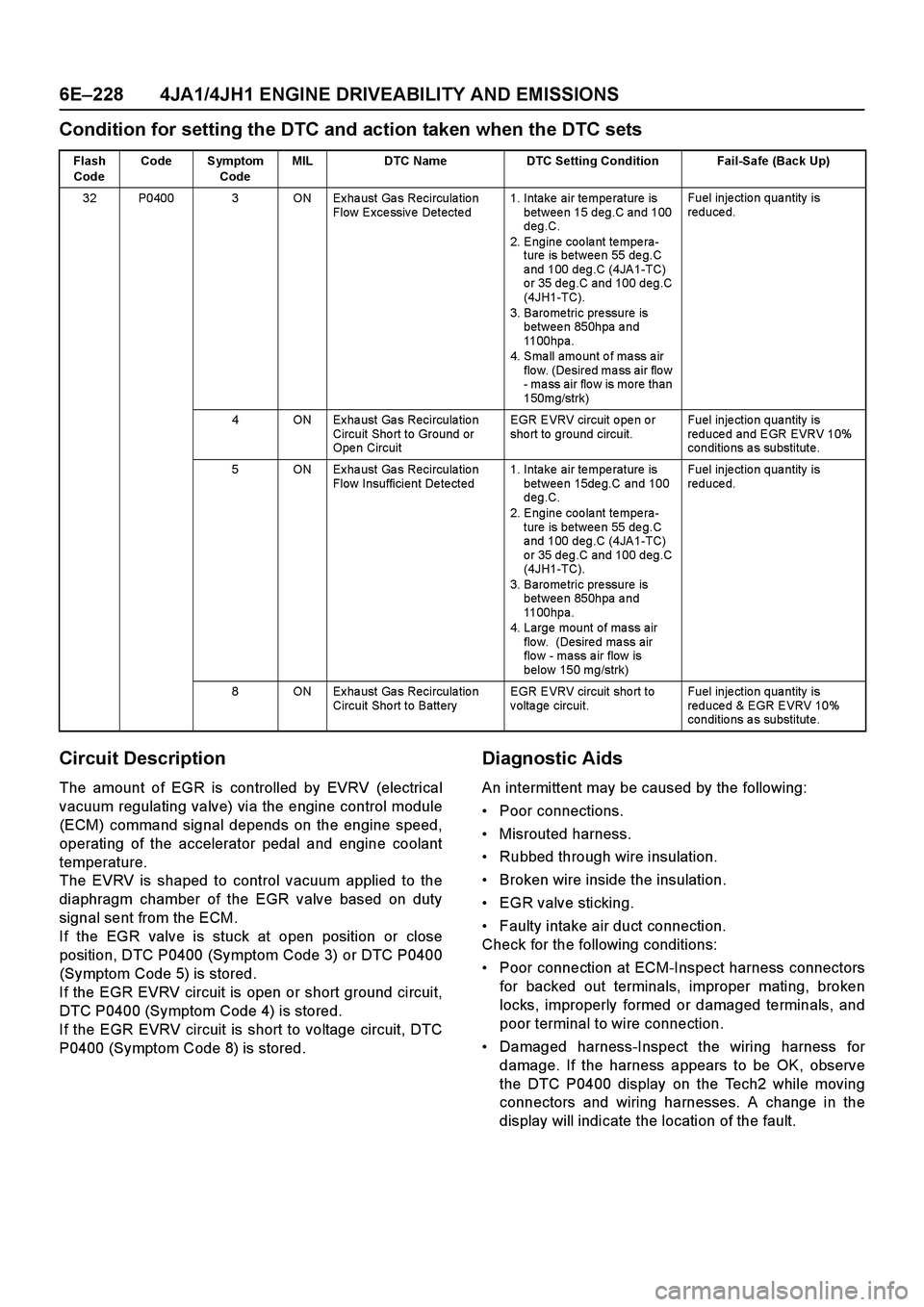
6E–228 4JA1/4JH1 ENGINE DRIVEABILITY AND EMISSIONS
Condition for setting the DTC and action taken when the DTC sets
Circuit Description
The amount of EGR is controlled by EVRV (electrical
vacuum regulating valve) via the engine control module
(ECM) command signal depends on the engine speed,
operating of the accelerator pedal and engine coolant
temperature.
The EVRV is shaped to control vacuum applied to the
diaphragm chamber of the EGR valve based on duty
signal sent from the ECM.
If the EGR valve is stuck at open position or close
position, DTC P0400 (Symptom Code 3) or DTC P0400
(Symptom Code 5) is stored.
If the EGR EVRV circuit is open or short ground circuit,
DTC P0400 (Symptom Code 4) is stored.
If the EGR EVRV circuit is short to voltage circuit, DTC
P0400 (Symptom Code 8) is stored.
Diagnostic Aids
An intermittent may be caused by the following:
Poor connections.
Misrouted harness.
Rubbed through wire insulation.
Broken wire inside the insulation.
EGR valve sticking.
Faulty intake air duct connection.
Check for the following conditions:
Poor connection at ECM-Inspect harness connectors
for backed out terminals, improper mating, broken
locks, improperly formed or damaged terminals, and
poor terminal to wire connection.
Damaged harness-Inspect the wiring harness for
damage. If the harness appears to be OK, observe
the DTC P0400 display on the Tech2 while moving
connectors and wiring harnesses. A change in the
display will indicate the location of the fault.
Flash
CodeCode Symptom
CodeMIL DTC Name DTC Setting Condition Fail-Safe (Back Up)
32 P0400 3 ON Ex ha ust Ga s Recircula tio n
Flow Excessive Detected1. Intake air temperature is
between 15 deg.C and 100
deg.C.
2. Engine coolant tempera-
ture is betwee n 55 de g.C
and 100 deg.C (4JA1-TC)
or 35 deg.C and 100 deg.C
(4JH1-TC).
3. Baro me tric pre ssure is
betwee n 850hpa a nd
1100hpa.
4. Small amount of mass air
flo w. (Desired ma ss air flo w
- mass air flow is more than
150mg/strk)Fuel inje ctio n qua ntity is
reduced.
4 ON Ex ha ust Ga s Recircula tio n
Circuit Sho rt to Ground or
Ope n CircuitEGR EVRV circuit open or
sho rt to ground circuit.Fuel inje ctio n qua ntity is
reduced and EGR EVRV 10%
conditio ns a s substitute.
5 ON Ex ha ust Ga s Recircula tio n
Flow Insufficient Detected1. Intake air temperature is
betwee n 15de g.C and 100
deg.C.
2. Engine coolant tempera-
ture is betwee n 55 de g.C
and 100 deg.C (4JA1-TC)
or 35 deg.C and 100 deg.C
(4JH1-TC).
3. Baro me tric pre ssure is
betwee n 850hpa a nd
1100hpa.
4. Large mount of mass air
flo w. (Desire d ma ss air
flo w - mass a ir flow is
below 150 mg/strk)Fuel inje ctio n qua ntity is
reduced.
8 ON Ex ha ust Ga s Recircula tio n
Circuit Sho rt to BatteryEGR EVRV circuit sho rt to
voltage circuit.Fuel inje ctio n qua ntity is
reduced & EGR EVRV 10%
conditio ns a s substitute.
Page 1660 of 4264

6E–288 4JA1/4JH1 ENGINE DRIVEABILITY AND EMISSIONS
Condition for setting the DTC and action taken when the DTC sets
Circuit Description
The TPS is a potentiometer connected to throttle shaft
on the throttle body. It is installed to the main TPS and
idle switch.
The engine control module (ECM) monitors the voltage
on the signal line and calculates throttle position. As the
throttle valve angle is changed when accelerator pedal
moved. The TPS signal also changed at a moved
throttle valve. As the throttle valve opens, the output
increases so that the output voltage should be high.
The ECM monitors the TPS supply voltage and TPS
output voltage. The supply voltage is out of range, DTC
P1120 (Symptom Code 7) or P1120 (Symptom Code 9)
will be stored. The output voltage excessively high, DTC
P1120 (Symptom Code 1) will be stored.
If the brake pedal is depressed during accelerator pedal
is depressing, DTC P1120 (Symptom Code D) will be
stored.
If the relation of idle switch and TPS position are
incorrect, DTC P1120 (Symptom Code E) will be stored.
Diagnostic Aids
An intermittent may be caused by the following:
Poor connections.
Misrouted harness.
Rubbed through wire insulation.
Broken wire inside the insulation.
Check for the following conditions:
Poor connection at ECM-Inspect harness connectors
for backed out terminals, improper mating, broken
locks, improperly formed or damaged terminals, and
poor terminal to wire connection.
Damaged harness-Inspect the wiring harness for
damage. If the harness appears to be OK, observe
the “Throttle Position”, “Idle Switch”, “Brake Switch 1”
and “Brake Switch 2” display on the Tech2 while
moving connectors and wiring harness related to the
sensor.
Diagnostic Trouble Code (DTC) P1120 (Sy mptom Code 1) (Flash Code 21)
Pedal/Throttle Position Sensor Circuit High Input
Flash
CodeCode Symptom
CodeMIL DTC Name DTC Setting Condition Fail-Safe (Back Up)
21 P1120 1 ON Pedal/Throttle Position Sen-
sor Circuit High InputThrottle position sensor out-
put voltage is more than 4.5V.ECM increa ses idle spe ed up
to 1400rpm.
7 ON Pedal/Throttle Position Sen-
sor Voltage Supply Circuit
High InputThrottle position sensor
power supply voltage is more
than 5.2V.
9 ON Pedal/Throttle Position Sen-
sor Voltage Supply Circuit
Lo w InputThrottle position sensor
power supply voltage is below
4.6V.
D ON Pedal/Throttle Position Sen-
sor Brake Switch Error1. Engine speed is more than
1700rpm.
2. Vehicle speed is more than
1.5km/h.
3. When brake pedal is
depressed during accelera-
tor pe da l is de pre ssing.
E ON Pedal/Throttle Position Sen-
sor Idle Position Switch Error1. Whe n idle switch is turne d
o ff, thro ttle positio n se nsor
wa s be lo w 0.35%.
or
2. Whe n idle switch is tune d
on, throttle position sensor
was more than 7.8%.
Step Action Value(s) Yes No
1Was the “On-Board Diagnostic (OBD) System Check”
performed?
—Go to Step 2Go to On Board
Diagnostic
(OBD) System
Check
Page 1670 of 4264

6E–298 4JA1/4JH1 ENGINE DRIVEABILITY AND EMISSIONS
Diagnostic Trouble Code (DTC) P1120 (Sy mptom Code D) (Flash Code 21)
Pedal/Throttle Position Sensor Brake Switch Error
Step Action Value(s) Yes No
1Was the “On-Board Diagnostic (OBD) System Check”
performed?
—Go to Step 2Go to On Board
Diagnostic
(OBD) System
Check
2 1. Connect the Tech 2.
2. Review and record the failure information.
3. Select “F0: Read DTC Infor As Stored By ECU” in
“F0: Diagnostic Trouble Codes”.
Is the DTC P1120 (Symptom Code D) stored as
“Present Failure”?—Go to Step 3Refer to
Diagnostic Aids
and Go to Step
3
3 1. Using the Tech 2, ignition “On” and engine “Off”.
2. Select “F1: Clear DTC Information” in “F0:
Diagnostic Trouble Codes” with the Tech 2 and
clear the DTC information.
3. Operate the vehicle and monitor the “F0: Read
DTC Infor As Stored By ECU” in the “F0:
Diagnostic Trouble Codes”.
Was the DTC P1120 (Symptom Code D) stored in this
ignition cycle?—Go to Step 4Refer to
Diagnostic Aids
and Go to Step
4
4 Visually check the TPS.
Check for the following conditions.
Accelerator pedal sticking.
If a problem is found, repair as necessary.
Was the problem found? —Verify repair Go to Step 5
5 1. Using the Tech 2, ignition “On” and engine “Off”.
2. Monitor the “Throttle Position” in the data display.
Does the Tech 2 indicate correct “Throttle Position”
from 0% to 100% depending on accelerator pedal
operation?—Go to Step 7Go to Step 6
6 1. Using the Tech 2, ignition “On” and engine “Off”.
2. Monitor the “Throttle Position” in the data display.
3. Adjust the TPS within 0% to 100%.
Was the problem solved?—Verify repair Go to Step 11
7 1. Using the Tech 2, ignition “On” and engine “Off”.
2. Monitor the “Brake Switch 1” and “Brake Switch 2”
in the data display.
Does the Tech 2 indicate “Inactive” when the brake
pedal was not stepped on?—Go to Step 13Go to Step 8
8 Adjust the brake switch.
Was the problem solved?—Verify repair Go to Step 9
9 Substitute a known good brake switch and recheck.
Was the problem solved?—Go to Step 10Go to Step 13
10 Replace the brake switch.
Is the action complete?—Verify repair—
11 Substitute a known good TPS and recheck.
Was the problem solved?—Go to Step 12Go to Step 13
12 Replace the TPS.
Is the action complete?—Verify repair—